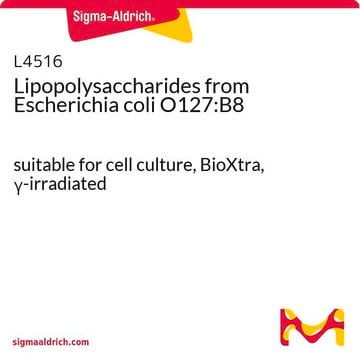L2630
Lipopolysaccharides from Escherichia coli O111:B4
purified by phenol extraction
Sinónimos:
LPS
About This Item
Productos recomendados
biological source
Escherichia coli (O111:B4)
Quality Level
form
lyophilized powder
purified by
phenol extraction
technique(s)
ELISA: suitable
cell based assay: suitable
ligand binding assay: suitable
impurities
≤3.00% protein (Lowry-TCA)
color
off-white to faint yellow
solubility
water: soluble
application(s)
cell analysis
clinical research
life science and biopharma
shipped in
ambient
storage temp.
2-8°C
¿Está buscando productos similares? Visita Guía de comparación de productos
General description
This product is phenol extracted from Escherichia coli serotype O111:B4. The source strain is from a private collection. This LPS serotype has been used to stimulate B-cells and induce NOS (nitric oxide synthase) in human hepatocytes.
Application
- for the stimulation of macrophages
- for LPS preconditioning in mice
- to induce acute kidney injury in mice
- to induce acute respiratory distress syndrome (ARDS) in mice to study the anti-inflammatory effects of bone marrow mesenchymal stem cell (BMSCs)-derived exosomes
- to induce hyperinflammatory status in severe acute respiratory syndrome coronavirus 2 (SARS-CoV-2) infected mice
Biochem/physiol Actions
Preparation Note
Other Notes
Related product
signalword
Danger
hcodes
Hazard Classifications
Acute Tox. 2 Oral
Storage Class
6.1A - Combustible acute toxic Cat. 1 and 2 / very toxic hazardous materials
wgk_germany
WGK 3
flash_point_f
Not applicable
flash_point_c
Not applicable
ppe
Eyeshields, Gloves, type N95 (US)
Certificados de análisis (COA)
Busque Certificados de análisis (COA) introduciendo el número de lote del producto. Los números de lote se encuentran en la etiqueta del producto después de las palabras «Lot» o «Batch»
¿Ya tiene este producto?
Encuentre la documentación para los productos que ha comprado recientemente en la Biblioteca de documentos.
Los clientes también vieron
Artículos
Explore the structure, function, and diverse applications of Lipopolysaccharides. Discover their role in bacteria, serological specificity, and research potential.
Explore the structure, function, and diverse applications of Lipopolysaccharides. Discover their role in bacteria, serological specificity, and research potential.
Explore the structure, function, and diverse applications of Lipopolysaccharides. Discover their role in bacteria, serological specificity, and research potential.
Explore the structure, function, and diverse applications of Lipopolysaccharides. Discover their role in bacteria, serological specificity, and research potential.
Nuestro equipo de científicos tiene experiencia en todas las áreas de investigación: Ciencias de la vida, Ciencia de los materiales, Síntesis química, Cromatografía, Analítica y muchas otras.
Póngase en contacto con el Servicio técnico





